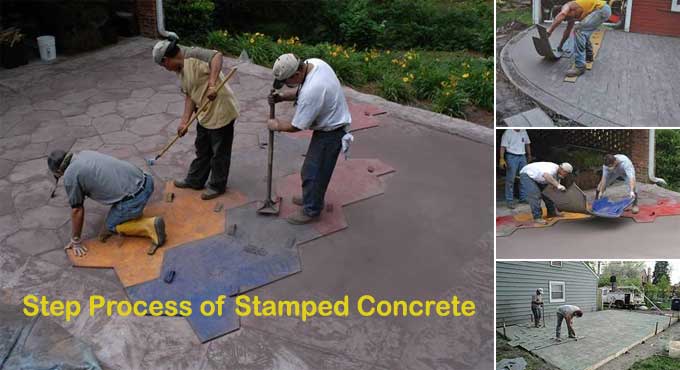
Installation of Stamped Concrete on a Construction Site

There is a lot of work involved in installing stamped concrete. Putting concrete down may not be problematic, but if imprinting is not properly done, you risk leaving a damaged slab that can become difficult and expensive to replace. When stamped concrete goes wrong, it is not easy to undo. Stamps must line up, patterns are laid correctly, and textures are correct. Add to that the fact that the entire process is slowed down by the fact that the concrete dries so quickly you can only stamp it in for just a few moments.
As long as you're not thinking of DIY stamped concrete, then you can rest easy knowing you're leaving all these variables to an experienced contractor to handle. Then take a look at this stamped concrete process overview. This will not give you a complete understanding of what is involved in stamped concrete when you do it yourself, but it will give you an overview of what is involved.
Sub-grade Preparation
Sub-grades affect the structural integrity and overall performance of the slab. Ideally, the soil under the concrete must be compacted well to prevent drainage and prevent soil erosion.
Placement of forms
A wooden, metal, or plastic form is attached to a stake to contain the concrete. It is vital that forms are in good condition, that the slope or grade for drainage is set correctly, and that they are installed in such a way that the corners about each other or structures separate neatly.
Reinforcement Installation
Steel reinforcing bars are required to provide structural support and function for the slab. As a result of reinforced slabs, cracks are controlled, structural capacity is added, impact resistance increases, and maintenance is decreased.
Placement of the Concrete
It is common for ready-mix trucks to pull up to a construction site and pour concrete from a chute, which is the most common method of placing concrete on site. It is best to place the concrete closest to its final destination in order to prevent it from being segregated by moving it around too much with shovels or other tools.
If concrete is splattered on adjacent structures, landscaping, or existing slabs, plastic sheeting should also be used as protection. Concrete type plays an important role in successful placement. If you do not have a proper mix design or slump, talk to your contractor about avoiding potential problems.
Finishing the Concrete
It is extremely important to create a perfect stamping canvas after concrete placement since this is when you will apply decorative stamping. For a well-defined impression, the surface must be leveled to eliminate any low or high spots, and the cement paste must be brought to the surface.
Color Applying
Stamping Concrete colored in a various ways.
The Stamping Process
Particularly in warm weather, there is a limited window for stamping. Schematizing the stamp layout in advance is essential. Furthermore, there should be enough labor on hand to complete the task. Pre-texturing edges is typically done first so that they do not overlap with forms in the future when large stamps are required and concrete cannot be fully pressed into them.
After the concrete has been placed, it must be stamped according to the same order. Checking the alignment of stamps and making sure random patterning follows are essential to achieving a realistic-looking outcome.
Curing Stamped Concrete
Curing or allowing concrete to dry, should maintain a sufficient moisture content long enough to allow essential properties of the concrete to develop. Concrete that has properly cured becomes denser and less permeable, increasing its strength and durability.
Installing Joints
Control joints, also called contraction joints, can be cut to help prevent visible cracks.
However, due to temperature changes and drying shrinkage, not all cracks can be prevented. To prevent cracking at random, stress relief can be provided at planned locations.
Sealing Stamped Concrete
Decorative stamped concrete cannot be completed without a sealer. This is the final step, in which sealers enhance the color and sheen of concrete surfaces. Surfaces are prevented from getting stained by efflorescence and soil penetration, as well as chemicals and leaves.


